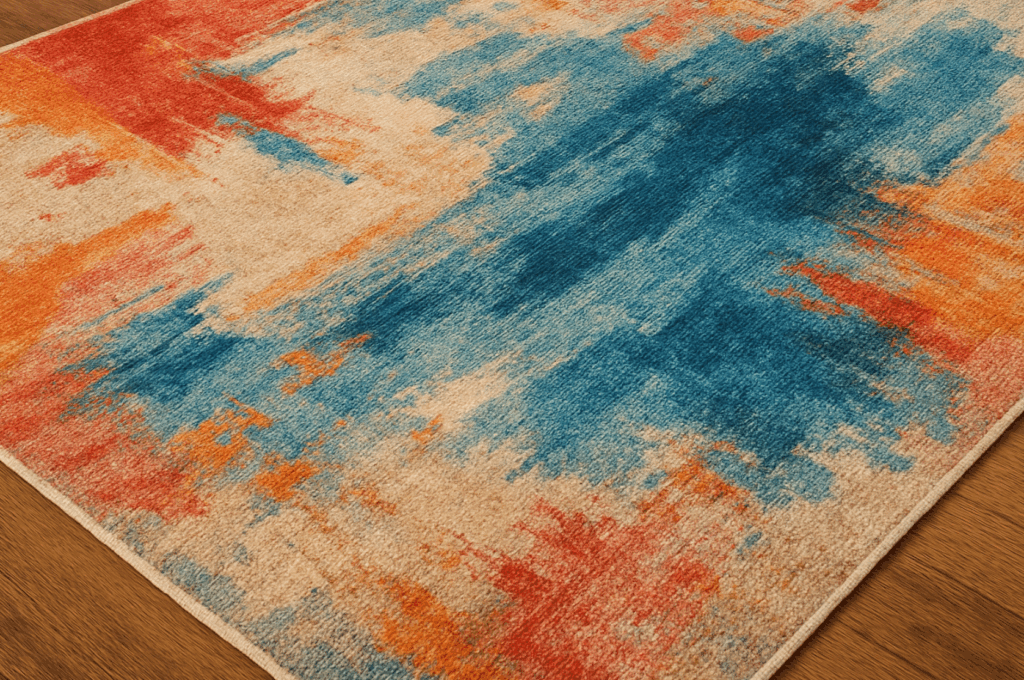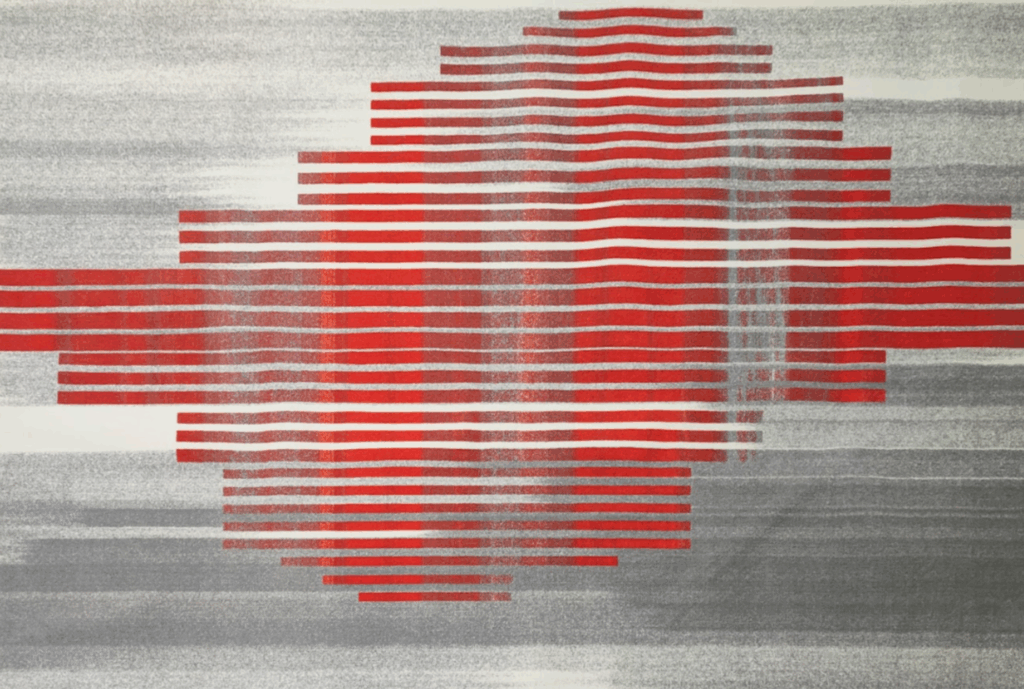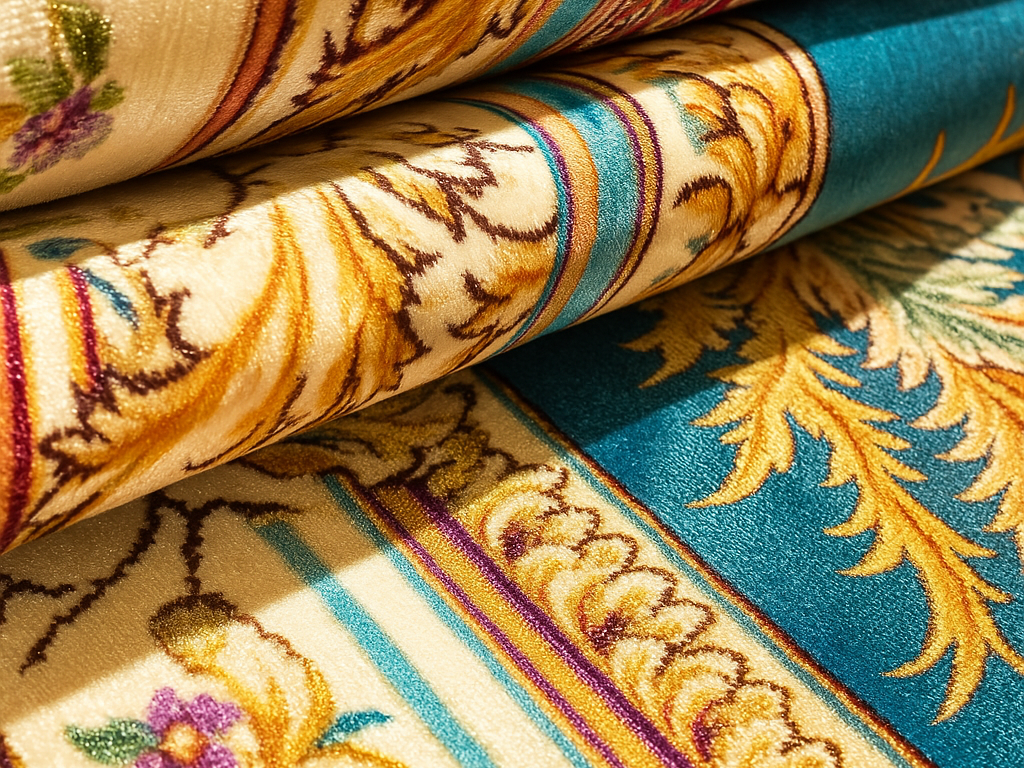When selecting the perfect carpet for your space, understanding the differences between printed and pre-dyed options is crucial. Each offers unique advantages and considerations that can significantly impact the aesthetics, durability, and maintenance of your flooring.

1. Understanding Printed Carpets and Pre-dyed Carpets
Printed Carpets: These carpets have designs applied after the carpet is tufted. Techniques like digital printing or injection dyeing are used to imprint patterns onto the carpet’s surface, allowing for intricate and customizable designs. However, the dye typically penetrates only the top layer of the fibers.
Pre-dyed Carpets: In this method, the fibers are dyed before the carpet is woven. This can be achieved through processes like solution dyeing, where color is added during fiber production, ensuring the dye permeates the entire fiber. This results in uniform coloration throughout the carpet.
2. Advantages of Printed Carpets and Pre-dyed Carpets
Advantages of Printed Carpets
Printed carpets, created by applying designs post-tufting, offer a range of benefits that cater to diverse aesthetic and functional needs.
- Unlimited Design Possibilities: Printed carpets excel in design flexibility. Advanced digital printing techniques allow for intricate patterns, gradients, and a vast array of colors, enabling customization to match specific themes or branding requirements.
- Faster Production and Turnaround: The printing process is typically quicker than traditional dyeing methods, resulting in shorter lead times. This efficiency is advantageous for projects with tight deadlines or last-minute design changes.
- Cost-Effective for Custom Designs: For bespoke designs, printed carpets can be more economical than weaving intricate patterns, as they eliminate the need for specialized yarns or complex weaving setups.
- Seamless Pattern Matching: Modern printing technologies ensure precise pattern alignment across carpet tiles, creating a cohesive and continuous design, even in expansive spaces.
- Eco-Friendly Options: Many manufacturers now use environmentally friendly inks and materials in printed carpets, reducing the ecological footprint compared to some traditional dyeing methods.
Advantages of Pre-Dyed Carpets
Pre-dyed carpets involve dyeing the fibers before weaving, resulting in distinct advantages, especially concerning durability and color consistency.
- Superior Colorfastness: Since the dye penetrates the entire fiber, pre-dyed carpets exhibit exceptional resistance to fading from sunlight or cleaning agents, maintaining their vibrant appearance over time.
- Enhanced Stain Resistance: The thorough dyeing process makes pre-dyed carpets more resistant to stains, as spills are less likely to alter the color, simplifying maintenance and cleaning.
- Ideal for High-Traffic Areas: Their durability makes pre-dyed carpets suitable for areas with heavy foot traffic, such as commercial spaces, offices, and busy households, ensuring longevity and sustained appearance.
- Consistent Coloration: Pre-dyed carpets offer uniform color throughout, minimizing variations and ensuring a consistent look, which is particularly beneficial for large installations requiring color uniformity.
- Resistance to Bleach and Harsh Chemicals: Certain pre-dyed carpets, especially those using solution-dyed fibers, exhibit high resistance to bleach and other harsh chemicals, making them suitable for environments where such exposures are common.
Related Read: What Is a Printed Rug? A Complete Guide to Styles, Benefits & Care
3. Disadvantages of Printed Carpets and Pre-dyed Carpets

Disadvantages of Printed Carpets
Printed carpets, while offering vibrant designs and customization, come with certain limitations that may affect their suitability for specific environments.
- Surface-Level Dye Penetration: The dye in printed carpets typically resides on the surface of the fibers, making them more susceptible to wear and fading, especially in high-traffic areas. Over time, this can lead to a noticeable loss of vibrancy in the carpet’s design.
- Limited Durability: Due to the superficial nature of the dye application, printed carpets may not withstand heavy use as effectively as other types. This can result in a shorter lifespan, particularly in commercial settings or busy households.
- Maintenance Challenges: While printed carpets can effectively hide minor stains and dirt, this characteristic can also make it more challenging to detect and clean spills promptly. Delayed cleaning may lead to permanent staining or damage.
- Design Permanence: The intricate and bold designs of printed carpets, while visually appealing, may not align with changing interior design trends. This can result in the carpet appearing outdated over time, potentially necessitating replacement to maintain a contemporary aesthetic.
- Environmental Considerations: The production process for printed carpets often involves the use of various chemicals and dyes, which may have environmental implications. Additionally, the shorter lifespan of these carpets can contribute to increased waste if replacements are needed more frequently.
Disadvantages of Pre-dyed Carpets
Pre-dyed carpets, known for their colorfastness and durability, also present certain drawbacks that should be considered when selecting flooring options.
- Limited Design Flexibility: Pre-dyed carpets are often restricted to solid colors or simple patterns, limiting the range of design options available. This can be a disadvantage for those seeking intricate or customized designs to match specific interior themes.
- Longer Lead Times: The process of dyeing fibers before carpet production can result in longer manufacturing times. This may affect project timelines, especially when specific colors or patterns are required.
- Higher Initial Costs: Pre-dyed carpets often involve more complex manufacturing processes, which can lead to higher upfront costs compared to other carpet types. However, this investment may be offset by the carpet’s longevity and reduced maintenance needs.
- Repair and Replacement Challenges: Matching the exact color of pre-dyed carpets for repairs or extensions can be difficult, as dye lots may vary between production batches. This can pose challenges in maintaining a uniform appearance across the flooring.
- Environmental Impact: While pre-dyed carpets are durable, the dyeing process itself can be resource-intensive, involving significant water and energy use. Additionally, the use of certain dyes and chemicals may raise environmental concerns.
Related Read: Printed Rug vs Tufted Rug: How to Choose
4. Differences Between Printed Carpets and Pre-dyed Carpets
| Feature | Printed Carpets | Pre-dyed Carpets |
| Design Variety | High; customizable patterns and colors | Limited; mostly solid colors |
| Color Penetration | Surface-level | Through the entire fiber |
| Durability | Moderate; prone to fading | High; resistant to wear and stains |
| Production Time | Shorter | Longer |
| Cost | Generally lower | Can be higher due to dyeing process |
Manufacturing Processes
Printed Carpets: These are created by applying dyes to the surface of a pre-constructed carpet, often using digital or screen printing techniques. This method allows for intricate designs and a wide range of colors. However, the dye typically penetrates only the top layer of the fibers, which can affect durability over time.
Pre-dyed Carpets: In this approach, fibers are dyed before the carpet is woven. Techniques like solution dyeing involve adding color to the fiber during its formation, ensuring the dye permeates the entire fiber. This results in uniform coloration throughout the carpet, enhancing its resistance to fading and wear.
Design Flexibility
Printed Carpets: Offer unparalleled design versatility. The printing process allows for complex patterns, gradients, and a vast palette of colors, making them ideal for custom designs and spaces requiring specific aesthetic themes.
Pre-dyed Carpets: While they provide rich and consistent colors, the design options are more limited compared to printed carpets. They are best suited for solid colors or simple patterns.
Durability and Colorfastness
Printed Carpets: Since the dye resides on the surface, these carpets may be more susceptible to fading, especially in high-traffic areas or under prolonged sunlight exposure.
Pre-dyed Carpets: The color is integrated into the fiber, offering superior resistance to fading and wear. This makes them particularly suitable for areas with heavy foot traffic or exposure to sunlight.
Cost Considerations
Printed Carpets: Generally more cost-effective due to the efficiency of the printing process and the ability to produce designs on demand.
Pre-dyed Carpets: Tend to be more expensive, reflecting the additional processes involved in dyeing fibers before weaving. However, their longevity can offer better value over time.
Maintenance and Cleaning
Printed Carpets: May require more careful maintenance to preserve the surface design. Regular cleaning should be gentle to avoid fading or damaging the printed patterns.
Pre-dyed Carpets: Easier to maintain due to the dye’s integration into the fiber, making them more resistant to stains and allowing for more rigorous cleaning methods.
Ideal Applications
Printed Carpets: Best suited for areas where design and aesthetics are paramount, such as boutique hotels, showrooms, or residential spaces seeking a unique look.
Pre-dyed Carpets: Ideal for high-traffic commercial spaces, offices, or areas where durability and ease of maintenance are critical.
Related Read: How to Clean Rugs at Home Using Baking Soda: A Step-by-Step Guide
5. How to Choose Between Printed Carpets and Pre-dyed Carpets
Selecting the right carpet involves evaluating various factors to ensure it aligns with your specific needs and preferences. Both printed and pre-dyed carpets offer distinct advantages and considerations. Here are some points to assist in your decision-making process:
- Aesthetic Preferences: If you desire intricate designs and vibrant colors, printed carpets are suitable. For a uniform and classic look, pre-dyed carpets are preferable.
- Usage Area: High-traffic areas benefit from the durability of pre-dyed carpets, while printed carpets are ideal for spaces where design is paramount.
- Maintenance: Pre-dyed carpets offer easier maintenance due to their stain resistance.
- Budget: Printed carpets are generally more cost-effective, making them suitable for budget-conscious projects.
6. Conclusion
Both printed and pre-dyed carpets have their unique advantages and are suited to different needs. Your choice should align with your design preferences, usage requirements, maintenance capabilities, and budget. By understanding the distinctions between these two types, you can make an informed decision that enhances the comfort and aesthetics of your space.
7. FAQs
Q1: Which carpet type is more durable?
- Pre-dyed carpets are generally more durable due to the dye permeating the entire fiber.
Q2: Can printed carpets be used in high-traffic areas?
- While they can be used, they may show wear and fading faster than pre-dyed carpets.
Q3: Are pre-dyed carpets more expensive?
- They can be, due to the more intensive dyeing process and longer production times.
Q4: Do printed carpets offer more design options?
- Yes, printed carpets allow for a wider range of patterns and colors.
Q5: Which carpet is easier to maintain?
- Pre-dyed carpets are easier to maintain as they resist stains and fading better.


